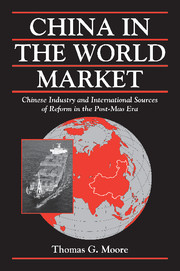Book contents
- Frontmatter
- Contents
- List of Figures
- List of Abbreviations
- Preface
- 1 China as a Latecomer in World Industrial Markets
- 2 The Outside World as an Impetus for Change in China
- 3 Tailor to the World: China's Emergence as a Global Power in Textiles
- 4 Beating the System with Industrial Restructuring: China's Response to the Multifiber Arrangement (MFA)
- 5 China Looms Large: Reform and Rationalization in the Textile Industry
- 6 Industrial Change in the Shadow of the MFA: The Role of Top-Level Strategy, Mid-Level Intervention, and Low-Level Demand in China's Textile Industry
- 7 Chinese Shipbuilding: The Modest Origins of an Emerging Industrial Giant
- 8 Dangerous Currents: Navigating Boom and Bust Cycles in International Shipbuilding
- 9 Chinese Shipbuilding and Global Surplus Capacity: Making a Virtue out of Necessity
- 10 Market-Oriented Solutions for Industrial Adjustment: The Changing Pattern of State Intervention in Chinese Shipbuilding
- 11 Who Did What to Whom?: Making Sense of the Reform Process in China's Shipbuilding Industry
- 12 External Shocks, State Capacity, and National Responses for Economic Adjustment: Explaining Industrial Change in China
- 13 China in the Contemporary International Political Economy
- Appendix Contours of the Research Effort
- Bibliography
- Index
4 - Beating the System with Industrial Restructuring: China's Response to the Multifiber Arrangement (MFA)
Published online by Cambridge University Press: 07 August 2009
- Frontmatter
- Contents
- List of Figures
- List of Abbreviations
- Preface
- 1 China as a Latecomer in World Industrial Markets
- 2 The Outside World as an Impetus for Change in China
- 3 Tailor to the World: China's Emergence as a Global Power in Textiles
- 4 Beating the System with Industrial Restructuring: China's Response to the Multifiber Arrangement (MFA)
- 5 China Looms Large: Reform and Rationalization in the Textile Industry
- 6 Industrial Change in the Shadow of the MFA: The Role of Top-Level Strategy, Mid-Level Intervention, and Low-Level Demand in China's Textile Industry
- 7 Chinese Shipbuilding: The Modest Origins of an Emerging Industrial Giant
- 8 Dangerous Currents: Navigating Boom and Bust Cycles in International Shipbuilding
- 9 Chinese Shipbuilding and Global Surplus Capacity: Making a Virtue out of Necessity
- 10 Market-Oriented Solutions for Industrial Adjustment: The Changing Pattern of State Intervention in Chinese Shipbuilding
- 11 Who Did What to Whom?: Making Sense of the Reform Process in China's Shipbuilding Industry
- 12 External Shocks, State Capacity, and National Responses for Economic Adjustment: Explaining Industrial Change in China
- 13 China in the Contemporary International Political Economy
- Appendix Contours of the Research Effort
- Bibliography
- Index
Summary
DEVELOPING COUNTRY STRATEGIES FOR COPING WITH THE MFA
The experiences of other developing countries suggest several ways that exporters can adapt to restrictions under the MFA: product upgrading to achieve higher unit values for goods subject to quotas; product diversification toward unrestricted goods; increased exports to countries that do not impose quotas under the MFA; improved utilization of existing quotas; moving production abroad legally via foreign investment to avoid quotas; and illegal transshipments of domestic production through third countries to avoid quotas.
First, with regard to product upgrading, there is a strong incentive under the MFA for exporters to trade up into higher-end goods since the quantity of their sales is strictly limited. If a specific product (e.g., men's cotton dress shirts) becomes subject to quotas, one strategy is to move upmarket from cheaper shirts sold at discount department stores to more expensive shirts sold at upscale department stores. Second, the imposition of quotas in one product line (e.g., women's cotton sweaters) frequently results in greater exports of unrestricted products (e.g., women's ramie sweaters). Third, the presence of quotas in one export market (e.g., the United States) often leads to increased exports to unrestricted markets (e.g., Japan). Fourth, another common response to the MFA is to ensure that quota allocations are fully utilized, a strategy that often requires both improved administrative coordination and adjustments to the product mix. Finally, the impact of restrictions can also be mitigated by avoiding quotas altogether, either by moving production overseas or through customs fraud.
- Type
- Chapter
- Information
- China in the World MarketChinese Industry and International Sources of Reform in the Post-Mao Era, pp. 80 - 110Publisher: Cambridge University PressPrint publication year: 2002



